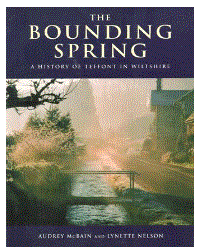Local History

But there is plentiful evidence of human occupation for thousands of years before this. Woolly mammoths were hunted nearby during the Ice Age and around 8000BC the Mesolithic people fashioned their flint tools at Ley Farm. The Neolithic people felled trees and cultivated land on the chalk soil of Teffont Magna in the period when Stonehenge was erected. Bronze Age tools have been found here - as have those of the Iron Age. Users of the latter seem to have lived in troubled times, necessitating the building of a fort on the edge of the village.
The Romans left more solid evidence behind; they quarried stone in Teffont Evias and farmed throughout the village. There was a Saxon presence for some centuries by which time the name (if not the spelling) of Teffont was in use - Tef being the Frisian for boundary and Fontana the Latin for Spring. This spring feeds the stream which travels down through the village, into the River Nadder, and was the main reason for the early occupation of Teffont.
By the time of the Norman Conquest the village had been divided into two - Teffont Magna was owned by Shaftesbury Abbey, along with the Manor of Dinton, and Teffont Evias was possibly owned by one Karlo who had been granted it, possibly by King Knut, early in the 11th century.
After the Conquest, all land was owned by the King; the Domesday Book records that Alfred, Baron of Marlborough, held Teffont Evias from him.
By the 13th century there was almost certainly a church in each of the two villages, although that in Magna had become a Chapel-of-Ease, subordinate to Dinton. Until the 20th century, there was no graveyard in Magna and dead bodies were wheeled over to Dinton along the Coffin Path to be buried there.
From the 12th century several prominent families, such as the Husses, the Tregozyes and the Hungerfords held land in Teffont Evias from the King. This meant that sometimes the villagers from Evias became soldiers while those in Teffont Magna, still owned by Shaftesbury Abbey, could concentrate on farming. The Hungerfords were overlords of Evias for 150 years but with the execution of Walter Hungerford who offended Henry VIII, the estate passed to Henry Lee in 1545, one of whose family became the Lord Treasurer and Earl of Marlborough and another a licensed pirate who explored the River Amazon. In 1652, the estate was sold to the Cromwellian supporter, John Ashe, and his family sold it forty years later to Christopher Mayne, from whom the present owners, the Keatinge family, are descended. It was one of Christopher Mayne's descendants, John Mayne, who, in the 19th century was responsible for enlarging the church and the Manor House, both attractive features of the village.
Read More: Please follow link http://www.teffont.org.uk/ to the Teffont Archaeology Project which is an archaeological research project which aims to develop understanding of the heritage of the villages of both Teffont Evias and Teffont Magna. The project from York university works in partnership with the local community to build stronger links with heritage.
Lynette is the co-author, with Audrey McBain, of the book,'The Bounding Spring' (ISBN 1-904377-26-2) (please telephone Anita Ridley – 01722 716548 for purchase information - all profits go to village charities) recounting the history of Teffont, written as part of a millennium project to celebrate the village's rich history.
